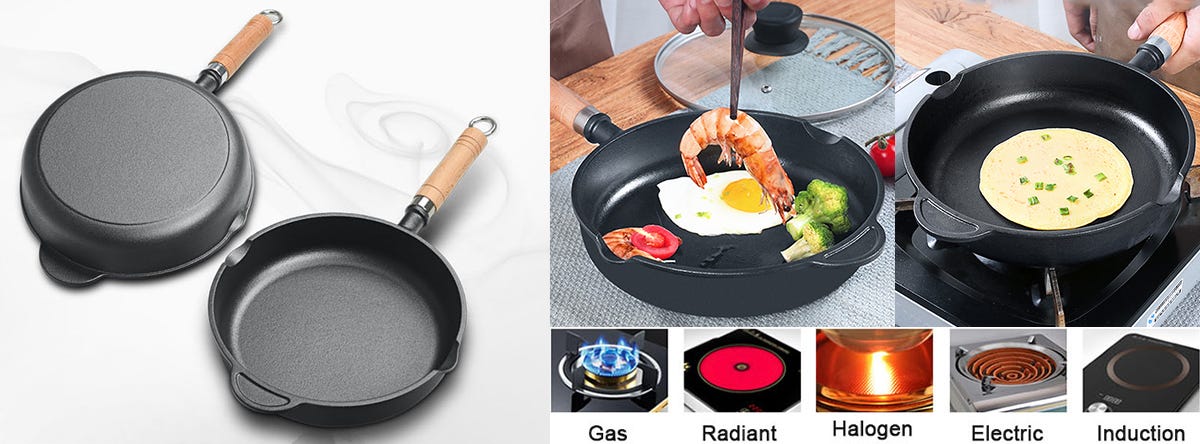How Do I Care For My Cast Iron Skillet?
 Applications of Cast Iron Skillet
Applications of Cast Iron Skillet
A cast-iron skillet is great for everything from baking perfect cornbread to roasting a chicken, and it will become naturally nonstick over time. The best cast iron skillet will be yours for a lifetime, so choosing the right one for you is an important task. These pans are a necessity for every home cook.
The double-sided frying pan Cast Iron Combo Cooker is one of Sarchi’s best-selling products and is also very popular in the market. It consists of a deep frying pan and a shallow frying pan. The two frying pans are each other’s lids. It is multi-functional, use to sear, sauté, bake, broil, braise, fry, or grill, and other cooking methods. Cast iron material, seasoned before leaving the factory, ready to use. The combination of the long handle and the vice handle allows you to easily control this cast iron pot.
This double frying pan is pre-seasoned with vegetable oil, and after being baked at high temperature, the surface of the griddle pan has a layer of vegetable oil, the double frying pan will be more non-stick, and not easy to rust. The oils used in our coating are all vegetable oils that meet the food grade, which is 100% natural and healthy.
How Should You Use Your Cast Iron Skillet?
Season it when you get it. Even pre-seasoned cast iron can provide some extra protection. To season your pan, heat it on the stove until it smokes, then rub a little oil in it and let it cool. Repeat this process a few times and you’re ready to go.
Clean after each use. Clean your pan thoroughly after each use, washing it with soap and water and wiping off any gunk or debris from the bottom.
Re-season. Rinse off any excess soap with water and place the cast iron skillet on a burner set to high heat. When most of the water in the skillet is dry, add ½ teaspoon of neutral oil such as vegetable, canola, flaxseed, or shortening. Wipe it over with a paper towel. Continue heating the pan until it starts to smoke, let it cool, and you’re done.
Deep fry and sear. What’s the best way to keep the seasoning on? Just use your pan a lot! The more you deep fry, sear, or bake, the better the seasoning will be.
Don’t let it stay wet. Water is the natural enemy of iron, and even a drop of water left in your pan when you put it away can cause rust. Not the end of the world, but rusting requires a little scrubbing and re-seasoning. I always dry my pans with a paper towel and then apply a small amount of oil before storing them.

How Do I Care For My Cast Iron Skillet?
1. Clean your cast iron skillet as soon as possible after using it, rather than letting it sit with food or liquids in it for several days. Contrary to popular belief, don’t be afraid to use a little soap. Soap will break down new fats and oils, but will not damage existing seasonings.
2. If your cast iron skillet has food stuck inside that cannot be removed with a sponge, try using a stiff bristle brush or scratch-resistant nylon or silicone pan scraper. Seasonings are hardy but can be removed if scrubbed hard or with an abrasive tool.
3. Dry the pan thoroughly after washing and use a paper towel to apply a thin layer of neutral oil to the inside and outside of the pan. This will protect the pan from environmental moisture.
4. Don’t leave a cast iron pan on a lit flame or in a hot oven for too long unless you are actually cooking with it, as prolonged exposure of an empty pan to high temperatures can damage it.
5. Cast iron is sturdy, but not infallible. Treat your pans with care, and if you are using an antique pan, avoid dropping it or tapping it excessively. Antique pans are thinner and more prone to cracking than modern pans.

How to Test If Your Cast-Iron Pan is Well Seasoned?
A well-seasoned skillet will have a dark, semi-glossy finish and won’t be sticky or greasy to the touch. It won’t have any rust or any dull or dry patches.
Frying an egg is an effective way to test the level of non-stick coating on a pan, as eggs have a tendency to really stick. To assess the efficacy of any pre-seasoning on an out-of-the-box pan, we first fry the eggs in a thin layer of oil. If the pan doesn’t have the original seasoning, we don’t judge its performance in this round-we just took the opportunity to add the first layer of natural seasoning to the cooking surface.
Next, also using a little oil, we baked half a potato, and cut the side down, in each pan for four minutes. This test allowed us to evaluate how evenly the cast iron skillet browned the food and how quickly it heated up, and to test the non-stick ability of each pan one last time.
We then cleaned the pans, lightly coated them with vegetable oil, and baked them at 500°F (or 450°F if they were only heat-safe at that temperature) for an hour to add a layer of seasoning (read more about how to season cast-iron skillets). Once cooled — for a very long time, due to the high insulation of cast iron! — We repeated the earlier test, again frying eggs and baking potatoes in each skillet.
Finally, we heated the oil in each pan and poured it into a separate container to test the handles and pouring spout of each model, taking into account weight and maneuverability.


评论
发表评论